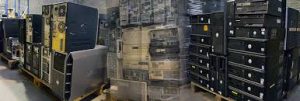happens to recycled computers
Recycling old computers is crucial for environmental sustainability and resource conservation. But what exactly happens to recycled computers once they are collected? The journey of recycled computers involves a series of steps aimed at recovering valuable materials, minimizing waste, and promoting responsible disposal practices. Here’s an overview of what happens to recycled computers:
Collection and Sorting: The process begins with the collection of old computers from various sources, including individuals, businesses, and electronic waste collection centers. Once collected, the computers are sorted based on factors such as brand, model, condition, and recyclability. This sorting helps determine the most suitable recycling methods for each device.
Data Destruction: Before recycle computers near me, it’s essential to ensure the secure destruction of any data stored on the computers. Data destruction methods may include data wiping, hard drive shredding, or physical destruction to prevent unauthorized access to sensitive information. Certified recycling facilities adhere to strict data security protocols to safeguard privacy and confidentiality.

What happens to recycled computers?
Component Removal: After data destruction, technicians disassemble the computers to separate various components and materials for recycling. This process involves removing components such as hard drives, memory modules, CPUs, motherboards, and peripherals. Each component is then sorted into designated bins for further processing.
Material Recovery: Once disassembled, the individual components are processed to recover valuable materials. For example, precious metals like gold, silver, and copper are extracted from circuit boards, connectors, and wiring. Plastics, glass, and other non-metallic materials are also separated for recycling or repurposing.
Refurbishment and Reuse: Components that are still functional or can be repaired are sent for refurbishment or reuse. Certified technicians inspect, test, and repair components such as hard drives, memory modules, and CPUs to ensure they meet quality standards. Refurbished components may be sold as replacement parts or used to build refurbished computers.
Material Recycling: Components that cannot be refurbished or reused are processed for material recycling. Metals, plastics, and other recyclable materials are shredded, melted down, or otherwise treated to extract raw materials for manufacturing new products. Recycling these materials reduces the need for virgin resources and minimizes environmental impact.
Hazardous Waste Management: Certain components of computers, such as batteries, cathode ray tubes (CRTs), and mercury-containing lamps, may contain hazardous materials that require special handling. Recycling facilities adhere to strict regulations for the safe disposal and management of hazardous waste to prevent environmental contamination.
Certification and Compliance: Many recycling facilities undergo certification processes to demonstrate compliance with industry standards and environmental regulations. Certifications such as R2 (Responsible Recycling) and e-Stewards ensure that recycling practices meet rigorous criteria for environmental sustainability, data security, and worker safety.
End-of-Life Disposal: In cases where components are not suitable for recycling or reuse, proper disposal methods are employed to minimize environmental impact. This may involve incineration, landfill disposal, or other approved methods of waste management. However, responsible recycling practices prioritize recycling and recovery over disposal whenever possible.
Documentation and Reporting: Throughout the recycling process, detailed documentation is maintained to track the flow of materials, ensure compliance with regulations, and provide transparency to stakeholders. Recycling facilities may also generate reports on the quantity of materials recycled, energy savings achieved, and environmental benefits realized through the recycling process.
In conclusion, the journey of recycled computers involves a comprehensive process of collection, sorting, disassembly, material recovery, refurbishment, recycling, and disposal. By recycling old computers, we not only conserve valuable resources and reduce waste but also promote environmental sustainability and responsible e-waste management. Through certified recycling facilities and adherence to best practices, recycled computers contribute to a circular economy where resources are reused, repurposed, and regenerated for a more sustainable future.
